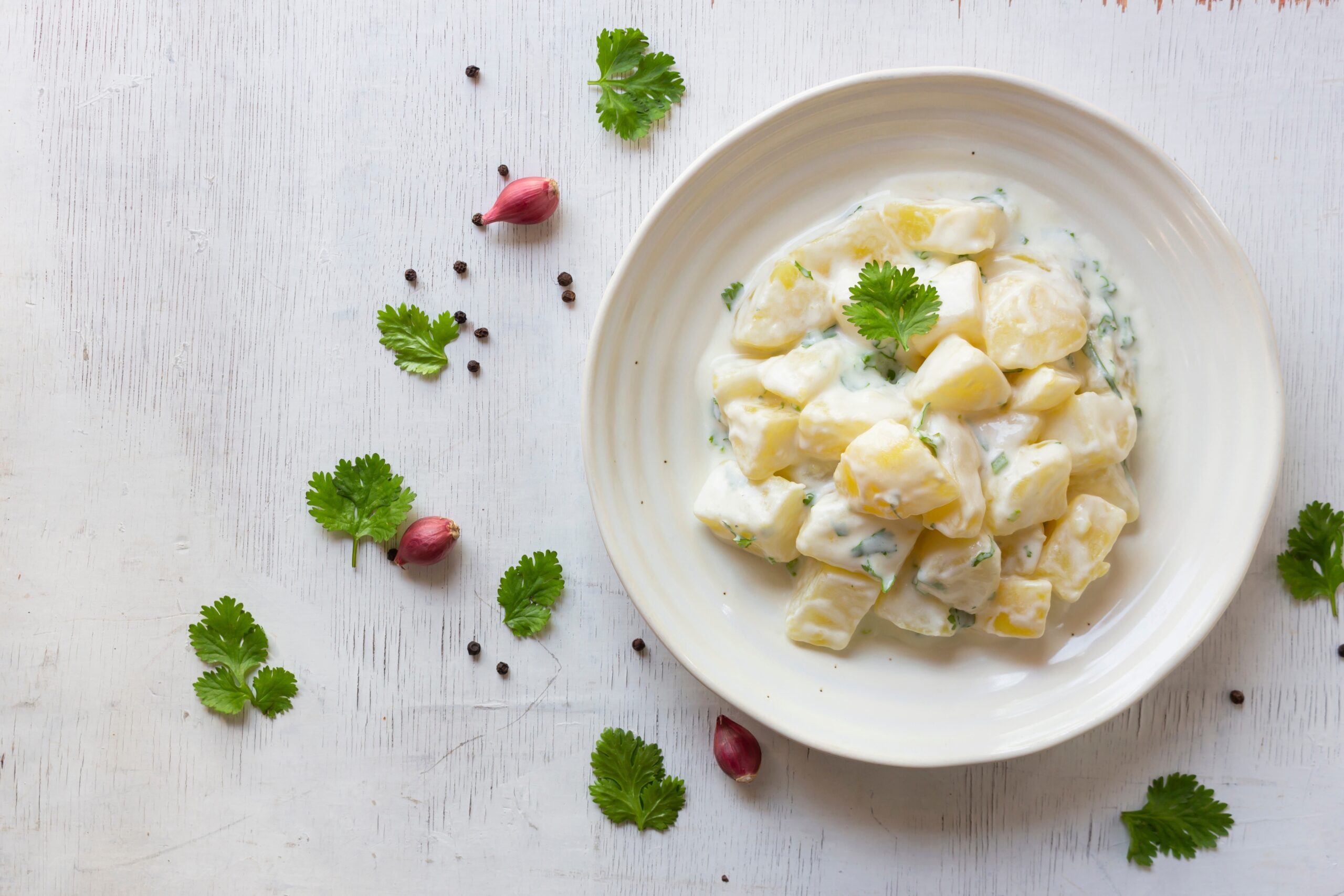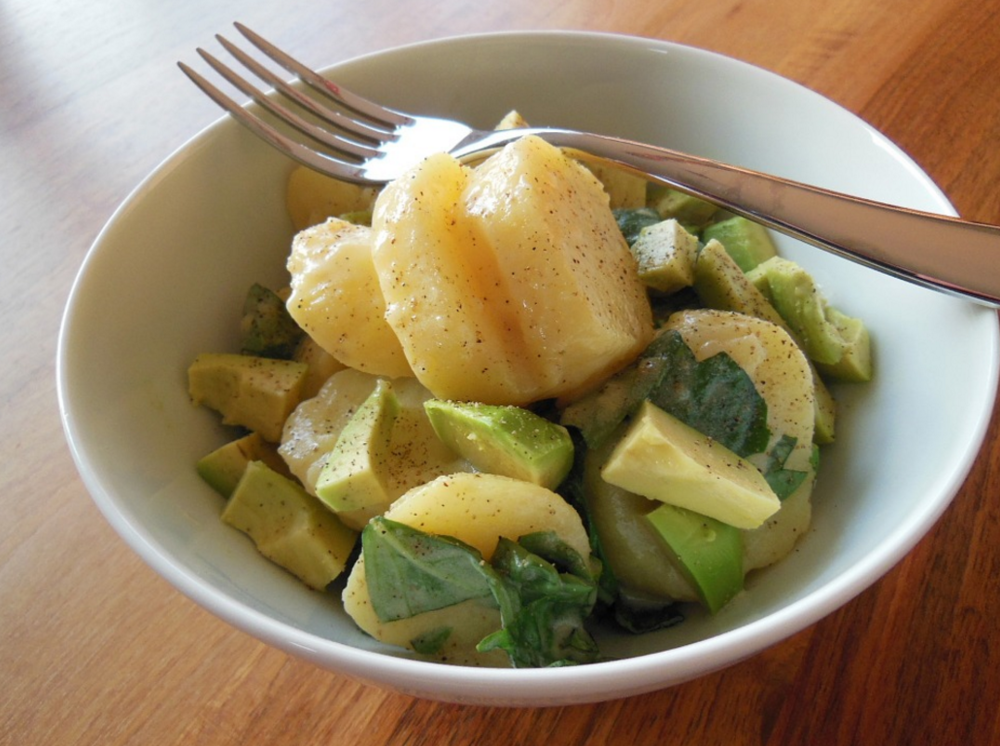

This easy to make early summer favorite has a healthy dressing of yogurt and herbs. Pitta types will benefit from the mildly bitter watercress leaves and cooling mint and fennel.
Eastern View: Often placed near the exit of an Indian restaurant is a tray of small colored candy. These are coated fennel seeds. They have a sweet, almost licorice-like taste. Chewing fennel seeds after a meal is a common practice in India. They aid in digestion and also freshen the breath.
Fennel may be used to decrease all three doshas: Vata, Pitta, and Kapha. It has a sweet, slightly astringent, and bitter taste, or rasa. It is cooling and its after-taste or vipak is sweet. Ayurveda advises against cooking fennel, as its active ingredients will die. It is better to steep fennel. Fennel is used as a digestive tonic, a mild laxative, and a diuretic. It also helps remove toxins from the body.
As a diuretic, and a urinary alkaline, fennel helps remove toxic substances from the body and assists in reducing rheumatism and swelling. Certain constituents of the essential oils in fennel are stimulants and they promote the secretion of digestive and gastric juices, reduce inflammation of the stomach and intestines, and aid in the proper absorption of nutrients from food.
This spice has anti-acidic and anti-spasmodic properties as well; it relieves intestinal spasms or cramps.Due to its fragrant smell, fennel is commonly used worldwide in toothpastes, breath fresheners, antacids, desserts, and in a variety of culinary creations
Western View: The iron, phosphorus, calcium, magnesium, manganese, zinc, and vitamin K content present in fennel all contribute to building and maintaining bone structure and strength. Phosphate and calcium are both important in bone structure whereas iron and zinc are crucial for the production and maturation of collagen
Maintaining a low sodium intake is essential for lowering blood pressure, but increasing potassium intake may be just as important because of its role in vasodilation, the dilation, and contraction of blood vessels. According to the National Health and Nutrition Examination Survey (NHANES), fewer than 2 percent of American adults meet the daily 4,700 mg recommendation for potassium.In addition, there is evidence that potassium, calcium, and magnesium decrease blood pressure naturally. All of these are present in fennel.
Dietary nitrates present in fennel and other foods have vasodilatory and vasoprotective properties. Because of this, they help to lower blood pressure and protect the heart.
Fennel’s fiber, potassium, folate, vitamin C, vitamin B-6, and phytonutrient content, coupled with its lack of cholesterol, all support heart health.Fennel contains significant amounts of fiber. As fiber helps lower the total amount of cholesterol in the blood, it decreases the risk of heart disease.
Potassium appears to promote heart health. In one study, those who consumed 4,069 milligrams of potassium per day had a 49 percent lower risk of death from ischemic heart disease compared with those who consumed around 1,793 milligrams per day.
Vitamin B-6 and folate prevent the build-up of a compound called homocysteine. When excessive amounts of homocysteine accumulate in the body, it can damage blood vessels and lead to heart problems.
Selenium is a mineral that occurs in fennel, but not in most fruits and vegetables. It contributes to liver enzyme function and helps detoxify some cancer-causing compounds in the body. Selenium can also prevent inflammation and decrease tumor growth rates. Fennel contains folate, which plays a role in DNA synthesis and repair. This may help prevent cancer cells from forming because of mutations in the DNA. The selenium found in fennel appears to stimulate production of killer T-cells. This suggests that it can improve the immune response to infection.
Choline is a very important and versatile nutrient in fennel that helps with sleep, muscle movement, learning, and memory. Choline also helps to maintain the structure of cellular membranes, aids in the transmission of nerve impulses, assists in the absorption of fat, and reduces chronic inflammation. An invaluable food that is classified both as a herb and spice!
For the salad:
3-4 potatoes, chopped into cubes
1 cup watercress
For the dressing:
3 tablespoons organic plain yogurt
2 tablespoons water
1 tablespoon sunflower oil
1 teaspoon maple syrup
1 teaspoon dried mint
1 teaspoon fennel fronds
1 tablespoon lime
Salt to taste
Put the potatoes in a pan, and add water to cover. Season well and bring to a boil. Reduce heat and simmer, uncovered, till the potatoes are tender, 15-20 minutes. Drain and let cool.
Put the potatoes and watercress in a large mixing bowl. In a smaller bowl, whisk all the dressing ingredients. Add the dressing to the potatoes and watercress and toss to evenly distribute the dressing. Taste and adjust seasoning.
Delicious served with veggie burgers or your favorite grilled chicken.
Want more meals that are not only good but good for you?! Take the Modern Dosha Quiz to discover your dosha and receive health, diet and lifestyle recommendations based upon your answers!
In health,


The Holistic HIghway integrates traditional Western medical practices with Ayurveda medicine, creating a focus on prevention through nutrition, diet, and exercise; use of the latest genetic testing and other diagnostic techniques; and prescribed combinations of botanical medicines, supplements, therapeutic diets, detoxification programs, or stress-management techniques.

Integrative Health Expert | Ayurveda Practitioner | Author | Speaker
Kerry is a globally recognized leader in integrative medicine and the science of health known as Ayurveda. She is passionate about raising awareness of the need for a change in contemporary medicine that focuses on patient empowerment and a health-based (rather than disease-based) medical system.
Kerry is connected with The University of Pittsburgh Center for Integrative Medicine and remains a pioneer in the field of integrative medicine where she has developed a personalized system to manage chronic disorders by incorporating fundamental changes in diet, behavior, and stress while focusing on genetics.
This individualized program is so successful that many of her clients have achieved maximum healing and vitality after years of chronic problems!
More to Explore
Contact
Disclaimer
The sole purpose of all the website content is to educate and provide information about Integrative Health, Genetics and Ayurveda.This information is not intended for use in the diagnosis, treatment, cure. or prevention of any disease.
Stay Connected
One Response
Ok, I got all the ingredients to make this recipe. I look forward to trying it.